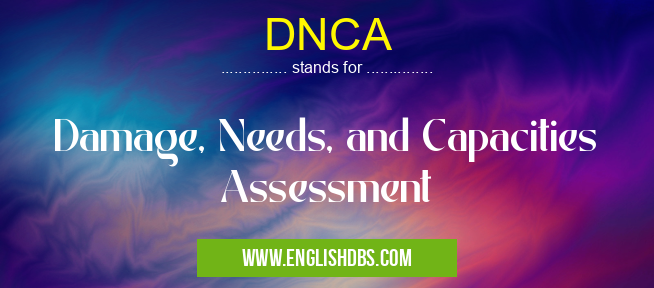What does DNCA mean in MILITARY
DNCA stands for Damage, Needs, and Capacities Assessment. This acronym is used frequently in the government sector and refers to the process of assessing a certain location’s state following a natural disaster or other emergency event. Reports generated from DNCAs are essential for developing recovery plans and helping the affected area return to normality.

DNCA meaning in Military in Governmental
DNCA mostly used in an acronym Military in Category Governmental that means Damage, Needs, and Capacities Assessment
Shorthand: DNCA,
Full Form: Damage, Needs, and Capacities Assessment
For more information of "Damage, Needs, and Capacities Assessment", see the section below.
» Governmental » Military
Essential Questions and Answers on Damage, Needs, and Capacities Assessment in "GOVERNMENTAL»MILITARY"
What is a Damage, Needs, and Capacities Assessment (DNCA)?
A Damage, Needs, and Capacities Assessment (DNCA) is a comprehensive evaluation of the impact of a natural disaster on an affected community. It helps to identify the needs of the community in terms of immediate relief assistance, long-term rehabilitation and reconstruction measures. The DNCA also evaluates the capacities of the community to support its own recovery efforts.
Who carries out DNCAs?
DNCAs are typically conducted by multidisciplinary teams consisting of representatives from government agencies, civil society organisations, aid organisations and other stakeholders.
What elements does a DNCA cover?
DNCAs analyse the physical damage caused by a natural disaster as well as its social, economic and environmental effects. The assessment also looks into factors such as existing vulnerabilities that may have exacerbated the impact of the disaster. Additionally, it seeks to identify what resources are available in terms of infrastructure and access to basic services for supporting recovery efforts.
What data does a DNCA rely on?
Data for completing a DNCA is gathered through primary research activities such as field visits and interviews with affected populations. Remote sensing technologies such as satellite imagery can be used to generate up-to-date information about the impacted area. Expert analysis is then used to interpret this data and draw conclusions about impact assessments and needs identification.
How is data collected during a DNCA?
Data for performing a DNSC is typically gathered through field visits by teams or representatives who are knowledgeable about disaster assessment techniques. These individuals can collect relevant information by conducting surveys with affected communities or observing conditions in the field directly. Other sources may include information from government agencies or local media channels.
How often should a DNSC be updated?
The frequency at which an assessment should be updated depends on several factors such as changes in geographical features or socio-economic conditions that could affect disaster responses and relief efforts over time. Generally speaking, it is recommended to update assessments every six months or when there has been significant change in any of these factors since an earlier assessment was undertaken.
How does a DNSC inform response strategies?
A comprehensive DNSC enables responders to make informed decisions when planning interventions that help affected populations recover from a disaster event quickly and efficiently while also taking into account long-term requirements for rehabilitation or reconstruction activities. By providing accurate information regarding impacts on social structures, resources availability, public infrastructure etc., an assessment allows planners to identify gaps in existing support systems so that appropriate actions can be taken.
Are there ethical considerations associated with performing DNSAs?
Ethical considerations are extremely important when assessing damages resulting from disasters as risk groups such as children or elderly people may require additional protection against exploitation related activities during relief operations or other forms of assistance delivery processes.Additionally, ensuring data confidentiality especially relating to sensitive personal information must be carefully respected in order not violate individual’s privacy rights.
Can NGOs use DNSAs when applying for grants?
Yes, many funders require detailed reports on damages caused by disasters along with associated needs which can be fulfilled through potential grant applications. An accurate DNGS provides up-to-date information necessary for successful grant applications ensuring donor organisations don't fall victim to misinformation.
Final Words:
In summary, DNCA stands for Damage, Needs, and Capacities Assessment – a process used by governments around the world after an emergency event has occurred in order to gain insights into its after-effects on people and infrastructure before formulating a plan of action based on these observations. These assessments are invaluable tools when it comes to providing assistance in recovering from large scale disasters like floods or earthquakes, making them indispensable documents in many countries' efforts towards preparing themselves against such incidents occurring again in future.
